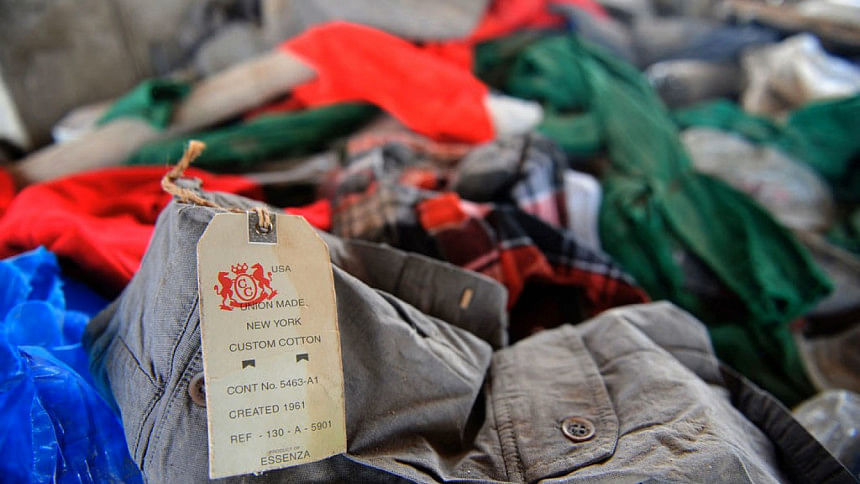To fight fast fashion, we must not throw our clothes away

Do you know clothing companies have been manufacturing 19 pieces of clothing for each person every year? Adding a further twist – four in five of us have clothing items stored in our wardrobes which have never been worn due to fitting or alteration issues. We all know that fashion keeps on evolving. To complement this trend, brands are investing in and accelerating the production of cheap and disposable clothing. Also, consumers' expectation is pushing the brands to launch countless new collections every season. As a result, people have been suffering from fashion fatigue – a state of constantly feeling out of date and exhaustion from purchasing more and more. The downside is, overbuying has been contributing to the growth of "throwaway culture," influencing the consumers to ignore the environmental cost of purchases.
Evidently, there is an ongoing trend of disregarding fast fashion as part of the push towards "circularity" – a model which enforces the principle of manufacturing fewer new items and earning more revenue by adopting recycling, repairing and resale schemes. Yes, you read it right: repairing. Globally, particularly in the developed countries, fixing instead of ditching clothing is gaining momentum. This is giving birth to startups and encouraging clothes manufacturers and stores to adopt a business model around clothes-repairing services. Already, a myriad of brands are ramping up their repair services to encourage customers to mend or alter damaged pieces of clothing instead of throwing them away. This is clearly aligned with the ongoing endeavour towards embracing sustainability and waste-reduction principle under SDGs.
During the pre-second World War period, particularly in Europe and the US, repairing and altering clothes were common, either at home or through a service provider. Back then, clothes were considered to be valuable assets, and for economic reasons, they were routinely repaired. As a result, costs associated with repairing were affordable in comparison to the price of new clothing. The post-war times enforced dynamic shifts in our lifestyle and social construct. This prompted the ready-to-wear market to flourish during the 1960s. Fashion trends became increasingly different with affordable and accessible items. Such trends facilitated a sharp decline in the long-held culture of mending and altering clothes. The rapid industrialisation and urbanisation trend created a different wave of economic mobility and social life. Consumers started considering repairing clothes as time-consuming and expensive in comparison to the availability and price of new clothes. This view quickly became the social norm in developed Western cultures and transferred to the Global South as well.
In the current era defined by digital transformation, there has been a revival of craft practices by the youth, which has facilitated renewed interest in creative repairing and alteration of clothing. However, this trend has to go a long way to get reestablished as it still orbits outside of dominant belief, that repaired clothing is a sign of financial hardship, and clothes should be discarded rather than repaired.
There is an urgent need to engage consumers in repair activities and wearing repaired items. To combat the dominant belief, manufacturers can embrace and disseminate the idea that wearing repaired garments is okay and culturally acceptable. To normalise this notion, responsibility sits on the shoulders of the designers as they can institutionalise the use of repaired clothes through introducing innovative design-led approaches in garments. On the other hand, governments can reintroduce home economics courses at schools focusing on basic sewing skills.
Zara recently surfaced its latest repair initiative, and also, in New York, Uniqlo has established a repair hub. Furthermore, different campaigns, for example, Sustainable Fashion Week UK's #MendItMay has been organised to encourage people in readopting the behaviour. Also, through popular media like TikTok, youngsters are encouraged to showcase their mending projects, inspiring others to revalue their clothes before they dispose. Interestingly, these activities pretty much resembled the second World War-government led "Make Do and Mend" campaigns in the US and the UK. In those campaigns, repurposing clothes was promoted as creative and resourceful strategies.
Slowly but surely, we will see an increasing number of initiatives by brands and companies to repurpose their marketing efforts towards promoting the durability, longevity and quality of their products. There is still much work to be done in driving business models towards a certain level where consumers willingly engage in mending practices and feel more comfortable with it.
Sabbir Rahman Khan is a knowledge management, communications, and advocacy professional.
Views expressed in this article are the author's own.
Follow The Daily Star Opinion on Facebook for the latest opinions, commentaries and analyses by experts and professionals. To contribute your article or letter to The Daily Star Opinion, see our guidelines for submission.

 For all latest news, follow The Daily Star's Google News channel.
For all latest news, follow The Daily Star's Google News channel. 









Comments